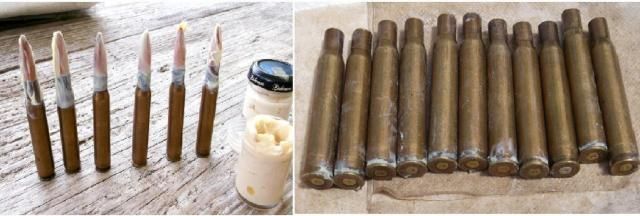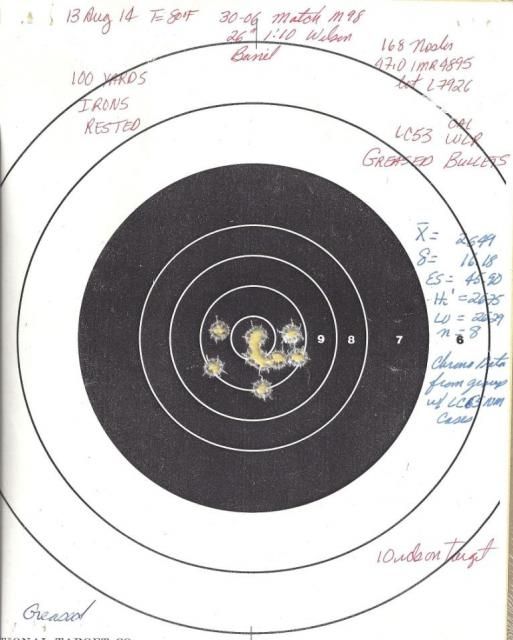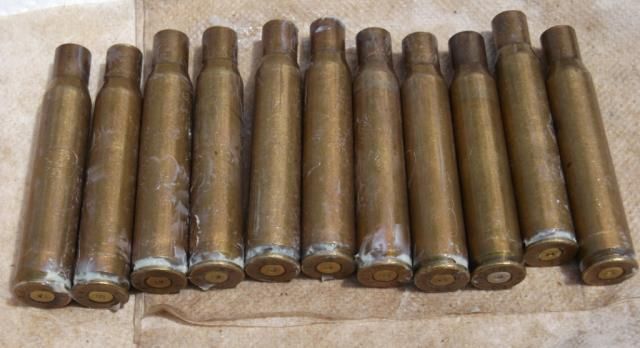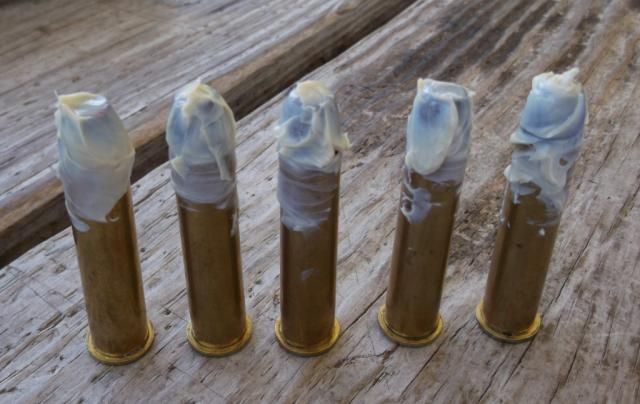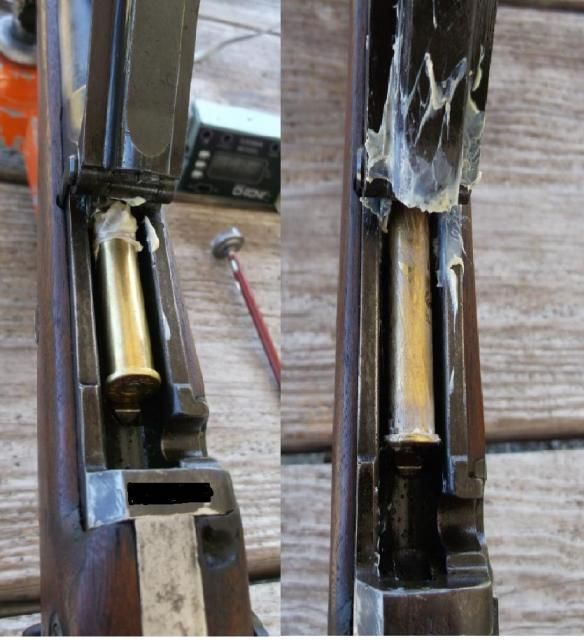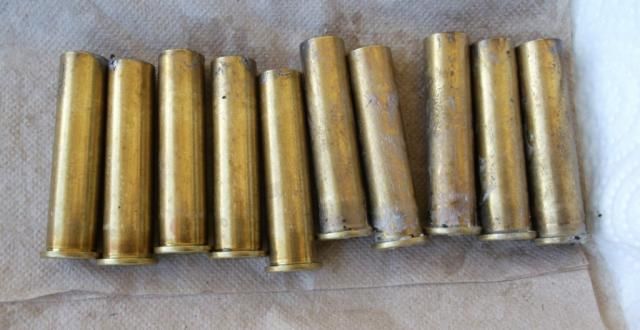That was Townsend Whelen's brainchild, IIRC. He'd got good results from tin-plated cupro-nickel bullets, in terms of reducing metal fouling, but they were all loaded fresh when he tested them, I expect. It was when they used them in National Match ammo one year in 1920's that the cold soldering was discovered to have occurred. So I think it was weeks or months, rather than days, but still way too short to let you keep the stuff around.
IIRC, Hatcher defended the practice, saying this ammo shot well and that the guns destroyed by it all turned out to have owners who were dipping the bullets into grease pots before loading, despite a published warning not to use grease with them. I suppose it's possible the grease helped the neck slip forward rather than sticking to the chamber wall as it expanded, and that might, indeed, promote the worst result, forcing a bullet and detached neck through the barrel. But it was basically asking for a problem to tin the bullets like that in the first place.
I have gone back and looked through the Arms and the Man issues on Google books and found the story is more complicated and convoluted than what Hatcher presented and what popular opinion thinks it is.
Major Townsend thought he had discovered the Holy Grail cure for jacket fouling. This would be a major technical accomplishment, something that seems not to have been found by even American commercial manufacturers. Major Townsend is running Frankfort Arsenal, he is in charge of all the men and resources, he has a very responsible position and now it is time for him to shine. You must understand, all these guys are very ambitious and want to make it to the top of chain of command. Solving a difficult technical issue like this would be just great on the Officer Evaluation Report.
What I see in the pages is that Major Townsend Whelen oversold the thick tin coating. He convinced his chain of command, the Council of Colonels who were organizing the National Matches, that the tin coating was the cure for all fouling ills. At the big National Match planning meeting, and I mean big, the number two guy for the Secretary of the Army was in attendance, the Council of Colonels decides, among other things, that since Major Whelen has eliminated bullet fouling, they wanted to get the grease out of service rifle shooting. Major Whelen is ordered to create up a pamphlet proving the evils of grease.
Now incidentally, well prior to the National Matches, Major Whelen writes about the weld between the tin coating and the case. He provides the same sort of numbers as Hatcher, and he adds that the bond between tin coating and brass case is so great that it will cause the case neck to pull off, or the case sidewalls to rupture. This is well before the National Matches. Understand there is quite a bit of self deception going on here. Humans are capable of incredible self deception. Here is Major Whelen observing these indications, and yet, ignoring the implications. No one apparently was asking "will this cause problems".
To add to the troubles, the Army excluded commercial manufacturers from the across the course ammunition to be used at the National Matches. Only Frankford Arsenal was allowed to make XTC ammunition. Commercial manufactures were allowed to compete to make the Palma ammunition. This is not trivial. These matches were hugely promoted, big spreads in the Arms and the Man, and any ammunition maker whose ammunition was proved, by test, to be the best, would get an enormous sales boost, not only for making match ammunition for the National Matches, but future sales. But again, only Frankfort Arsenal is funded for the across the course ammunition.
The pre National Match tests showed that the tin can ammunition shot well. The Army ballyhooed this to the shooting world. It was another Army triumph, the Army is proving its mastery over the arcane arts of metallurgy and accuracy, etc, etc, etc.
In the mean time, two articles come out in the Arms and the Man proving the evils of grease. The first one out is by Capt Crossman. He begins with what I think was the real concern at the time of the Council of Colonels: dirt. Grease attracts dirt, dirt scratches steel. Since the Army is loaning lots of rifles, and shooters receiving loaner rifles are not concerned with the long term heath of the loaner rifle, you can sort of understand why the Army did not want to have to rebuild or rebarrel every rifle loaned out at the National Matches. Then Crossman tries to make the grease issue a safety issue. I am not going to spend too much time on this path, but his data set actually shows that pressures are not increased by the use of grease, but rather, it shows that pressures are decreased. Crossman does not understand statistics at all, but picks on an high extreme spread in the greased data set, to make a case that greased bullets increase pressure. If he understood statistics, he would be embarrassed by his histrionics, because the high pressure result is entirely explainable by chance, and within the bounds of his data.
What is further interesting, Capt Crossman is aware of Swiss greased bullets.

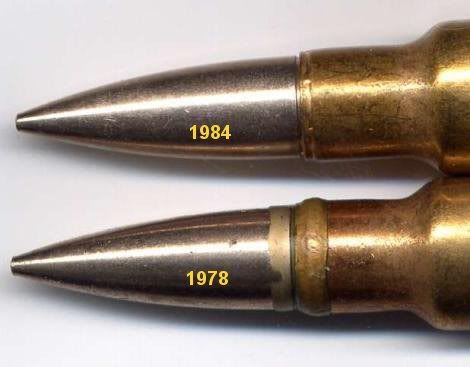
The Swiss greased the bullets of their service rifle ammunition up until the 1980's. What is even more interesting to me, is how these self proclaimed Ordnance Experts were ignorant of Austrian greased bullets, Italian greased bullets, and Russian greased bullets. All of the latter countries had been using steel jacketed bullets, prior to WW1, and to prevent barrel wear, they greased their bullets. Sometime around WW1 these nations have figured out to make non fouling bullet jackets, and except for the Swiss and Austrians, dump grease.
A TREATISE COVERING THE MANUFACTURE Of RIFLE CARTRIDGE CASES, BULLETS- 1916
http://archive.org/stream/cartridgemanufac00hamirich/cartridgemanufac00hamirich_djvu.txt
Cupro-nickel jacketed bullets are generally employed for military rifles and are used by the Belgian, British, Canadian, Danish, Italian, Roumanian, Russian, Spanish, and American governments. The German, Greek, Dutch, and Turkish governments use steel envelopes coated with cupro- nickel ; Austria uses greased steel, and Japan, copper. Bullets coated with cupro-nickel are likely to set up metallic fouling in the bore of the gun, consisting of streaks of metal which adhere to the lands and grooves in the bore.
Bullets with greased steel envelopes do not appear to cause metallic fouling, but they wear away the rifling in the gun much quicker.
The bullet used in the Swiss rifle cartridge is of a peculiar construction. The body is made of a hard lead alloy, provided with a nickel-plated steel envelope covering the point only, the remainder of the bullet being covered with paper lubricated with vaseline. The lower portion of the bullet which enters the cartridge case is smaller in diameter than the jacketed portion. The wounding power of this bullet is great, but its velocity is not as great as those provided with the full envelope.
Americans had been greasing their bullets for a very long time, this is an interesting pro grease article in the Arms and the Man.
(Google books)
27 April 1918 Rifle Training in War, part 4 Major Smith Brookhart
The use of greased bullets in rifle training is very desirable. There was a time when riflemen argued about the effect of grease upon the accuracy of the rifle but it long ago ended in favor of the grease.
The Winchester Company is now making all of its tests of both rifles and ammunition with greased bullets. When bullets were fired dry it was found the ammunition from the first loading machines would give the best velocity, with slightly reduced velocities apparent in the product of succeeding machines although fired from the same rifle. After they began greasing the bullets the velocity held even and steady. The results from the last machines were just as good as the first. It is true the velocity of greased bullets is higher, but it is even. They all go the same, providing they are greased about the same. It was claimed that grease in the chamber caused the primers to blow uot but that is a mistake. There is a higher pressure caused by the more perfect sealing of the bore when grease is used, but the pressure is not increased enough to blow out a properly seated primer.
The greatest benefit of the greased bullet is its effect upon the life of the rifle. In tests a few year ago all of the rifles which figured in the trials were worn out and lost their accuracy under three thousand round when fired with dry bullets. Those fired with greased bullets held their accuracy from 6700 to 7200 rounds. Accuracy as used here must not be confounded with “serviceable” as applied to the ordnance tests. These rifles showed no loss of accuracy until they had fired the above number of rounds and without the grease they showed loss of accuracy upon firing less than half the number. If the use of grease ill double the life of a rifle, it is very important.
Grease also prevents metal fouling and prevents acid fouling for the powder. It is a fine preservative for the bore of the rifle, but it has some disadvantages. As generally used it is dirty and disagreeable to handle. If mixed with sand and dirt it is very injurious to the rifle. It must e kept clean and it must be applied evenly. A small amount on each bullet is sufficient. It causes a certain amount of smoke and that may prevent its use on the battle field and especially by snipers. Nevertheless, it protects the rifle and ought to be used during the training period. If a bad quality of grease is used it causes carbon fouling.
Mobilubricant, Polarine, cup grease, or Keystone Journal grease may be used by putting the point of each bullet in the grease or by rubbing it over the bullets on a whole clup. Blue ointment used in the same way makes an excellent bullet grease. The best plan is a compound of 40% beeswax and 40% Carnauba wax and 20% Petrolatum. This must be melted and the bullets must be warmed and dipped into it. If the bullets are cold they take too much. They can be warmed with hot water. This compound hardens, is clean and easy to handle. When fired it leaves a trace of smoke along the entire course of the bullet, but that is no disadvantage in training. The great riflemen of the United States have nearly all used greased bullets during the last half dozen years.
Metal fouling is also entirely prevented by the use of greased bullets.
The rifle is preserved and its life prolonged by the use of greased bullets.
The use of grease is fool proof.
The only possible injuries that can result from its use arise when sand or dirt becomes mixed with and scratch the bore or when grease closes up the bore and bursts the barrel.
Both are easily avoided.
The writer has ample proof of these conclusions. He has commanded riflemen when the won world championships with rifles that had been fired more than 3000 times without any cleaning whatever. But every bullet had been greased. One of these rifles that had fired over 3300 rounds without cleaning the bore, showed signs of loss in accuracy at 1000 yards the day before the Palma match in 1912. The bore was wiped out and a collection of hard baked carbon fouling was found near the muzzle. This was removed with a steel brush and next day that rifle put on 216 points out of a possible 225 at 800, 900, and 1000 yards. This was the second score in the team that made the world’s record in the Palma match-and the man who made 217 also greased his bullets. This rifle fired 3300 rounds before cleaning of any kind was necessary, and then was only because of a carbon fouling which was easily removed. There was no acid reaction. Since that date other riflemen have won the Herrick, the Wimbledon, the Marine Corps and the Regimental Championship with the same treatment of their rifles. These are the greatest test of accuracy in the United States. The failure to clean the ordinary fouling from the rifle daily, was no advantage. Neither did it cause any injury. A better way would be to wipe it out and oil, but the burned grease is a protection and not an injury to the bore.
It would save many million of dollars lost in worn out rifles if the War Department would prohibit the use of the solutions and instead-
Issue the beeswax, Carnauba wax and petrolatum compound for greasing bullets.
It would increase the efficiency of men in rifle practice.
It would make rifle cleaning easy and preserve the rifle.
The president of the National Rifle Association now has a rifle that has fired over 7000 rounds of greased bullets and is still at its best for accuracy It has never been treated with the solutions.
So to get back to Crossman, he knows the Swiss use greased bullets, but he blows it off as a joke. He claims that he does not know if the greased ammunition is used as a regular service round, or is instead a special round that the Swiss use to shoot holes in cheese. If I were a Swiss national I would be rather insulted by this. Crossman does not think the Swiss are a national of rifleman, but rather, a nation of morons. From his viewpoint the Swiss Army loads up their service rifles with greased bullets, then they all start shooting holes in "Swiss Cheese", none of them ever noticing the dead and dying lying around with blown up rifles.
So, Crossman makes a hilarious, rip roaring, read about the evils of grease. This is the first of the bed rock articles that the American shooting community considers as gospel for greased bullets being dangerous.
Months later Frankford Arsenal comes out with a technical article on the evils of greased bullets. I have looked at it, the data is all over the place, some greases not so bad, vaseline was particularly bad, the whole conclusion is that greased bullets dangerously raise pressures. And the whole thing is bogus. Again, these "experts" are oblivious to what other countries are doing and thus don't address why foreign ammunition is perfectly safe with greased bullets, but American ammunition is dangerous. What I think really happened, is that Major Townsend Whelen comes back from the Council of Colonels to prove the evils of grease, and his minions provide the data set he wants. This happens all the time. When the tester is not independent of the chain of command, the chain of command gets the results they want, regardless of whether the results are true or not. The second article is the other bed rock foundation for General Hatcher claim's, Hatcherites, and Hatcherism.
Still all this is playing out about six months before the National Matches. Major Townsend Whelen has made the most fantastic, non fouling ammunition in the universe. Since bullets fouling is a thing of the past, getting grease out of the National Matches in any way possible is justified: a good thing.

All that can happen from hence forward is Army Triumph after Army Triumph.
Funny things happen on the way to the forum. Just before the National Matches there is a published account of the Wakefield Matches. The shooters had been warned not to get a bit of oil or grease on their rounds. But their rifles are blowing up on the line with the tin can ammunition. Since they were told the ammunition was perfectly safe, but that oil or grease dangerously increases pressure, they look for signs of oil coming out of the wood, and other such things, to explain the high pressures they are seeing. I recall the author saying they had cleaned their rifles out with gasoline, and yet, oil had to be getting on the ammunition. They are seeing things that are not there. Higher authority has convinced them that the only explanation for high pressure is a lubricant, and since that is the only assignable cause, they are seeing lubricant where none actually exists. But, and this is the most important but, the tin can ammunition fouls. It fouls as badly as the old cupronickel ammunition. And the tin fouling is just about impossible to remove as the old fouling mixes won't dissolve it.
This is very important to a precision shooter. For those who have never shot ammunition that fouls a barrel, and fouls badly, fouling changes point of impact. It changes point of impact randomly, inconsistently, and as the string continues. If you want to be National Champ, get your picture holding the Trophy in the Arms and Man, fouling will destroy all those hopes, as your shots won't go down the middle. So, just before the National Matches it is reported that the tin can ammunition fouls just as badly as the old ammunition. I have no doubt the word got out quickly, and those who wanted to win, took their greased bullet kits with them to the National Matches.
Now remember, with new ammunition the bullet pulls were around 600 psia. Early on, Townsend Whelen had created a bore obstruction with that thick tin coating bonding to the case neck. As time went on the migration of tin to brass continued and made the bond stronger. And when this ammunition was introduced at the National Matches, with literally thousands of shooters, firing millions of rounds, rifles blew up. This was extremely embarrassing to Major Townsend Whelen and the Army. From the historical record, it is clear the Army quickly figured out they had an ammunition problem and they recalled, and destroyed all the tin can ammunition they could, and issued warnings not to shoot the stuff. You can imagine with all the pre National Match ballyhoo about the Army's superlative technical competence in making the worlds best ammunition, nay, the best ammunition that every was and every will be, and what actually happened was that their perfect ammunition ended up blowing up rifles.

I am quite certain that Remington, Peters, Winchester, etc, all ammunition makers, were quick to point out that their ammunition shot well, and did not have the unfortunate effect of blowing up rifles.

Things like this can be a career ender. Here is Major Townsend Whelen, given the full resources of a Government Arsenal, and with all that, he could not figure out he had created a dangerous bore obstruction with his ammunition. He spend millions making all this ammunition, and what remains, has to be trashed. And also, like the Pied Piper, he led his leadership down into the river to drown. Higher level authority does not like being embarrassed by incompetent subordinates, and things like that show up in Officer Evaluation Reports. But, for both the Army, and Major Townsend Whelen, they had a "get out of jail card": prior to the National Matches they had proved that grease dangerously raised pressures. So of course, they were able to tell the public, tell all those other important people, that Army Ammunition was perfect, the real problem was those shooters, with their grease kits, greasing those bullets.
Here is the official coverup in print:
The National Match Ammunition
1 Oct 1921 Arms and the Man, Editorial by Brig-Gen Fred H. Phillips, Jr, Secretary NRA
Use of the national Match ammunition through the Camp Perry shooting season has amply demonstrated that, in the hands of intelligent rifleman, the “tin can” cartridge may be regarded as absolutely safe.
The fact that the National Matches closed without recording one serious accident in connection with the use of this ammunition seems to be a final and clinching argument, that when properly handled, no disastrous results may be expect. The only instance of rifles having been damaged-there were two out of the thousand-odd in use that suffered from “blow back”-were cause the presence of grease in excessive quantity and were the result of the shooter’s own carelessness. Fortunately the men who experience the blow backs were only superficially hurt. The lesion, however, in connection with the blow backs was plain.
The high degree of accuracy attained in the manufacture of this ammunition cannot be question. It is without a doubt the finest machine-made product that has ever been turned out.
The high quality of this ammunition, together with the remarkable accuracy properties of the new type of National Match rifle will do a very great deal toward promoting the art of marksmanship. …..
Whether the new “tin can” type ammunition may be regarded as a suitable service load for use by troops in the field is a matter for later an more mature determination. But little more could be expected in accuracy and wind bucking qualities from a strictly machine-made product than that exhibited by this year’s tin-plated ball cartridges.
So there you have it. Only stupid people, who use grease, have their rifles blow up. The tin can ammunition is the apex of human technological advancement, but its future is uncertain.
But of course, having preached to the multitudes the virutes of the tin coating, how those tin coated bullets were the best thing in human history, in another magazine, a writer asked Major Townsend Whelen the obvious question: "are we going to see more tin can ammunition in the future".
Field and Stream July 1922
Modern Rifle Ammunition, by Major Townsend Whelen
The metal of which the jackets are made is a most important item in the making of good bullets. If the jacket metal be too soft, or too brittle, and particularly if it be dirty of contain scale, the bullet will be poor, and it may cause considerable damage to the bore. Until very recently cupro-nickel was almost universally used for bullet jackets for the ultra high velocity rifle cartridges. There are many objections to the use of this metal. It is expensive, and it is hard to obtain it in good quality. It cases metal fouling in the bore. This metal fouling accumulates from shot to shot, gets (text missing) good lot of this metal, and put it aside and guard it most jealously for use in their Palma ammunition, other cartridges on which their reputation for accuracy is at stake. Cupro-nickel is really to be regarded as obsolete for bullet jackets.
In the 1921 ammunition for the National Matches an experiment was made in plating the cupro-nickel jackets of the bullets with a tin coating about 0.0003 inch thick. It is well known that the lubricating effects of tin at high temperatures prevents metal fouling when cupro-nickel jacketed bullets are used. The tin also seems to ease the bullet from the case, through the bullet seat, so as to get it entered in the bore with the minimum deformity. Superb accuracy was obtained with this ammunition and as a result every shooting record was broken last year. This ammunition did not cause lumpy metal fouling. But there was an aftermath to the use of tin-plated bullets which makes it extremely unlikely that such a plating will ever be used again. If you suspend iron in melted tin, the tin will eat away the surface of the iron. Something akin to this occurs very quickly with tin bullets at the temperatures occurring the bore of the rifle. An examination of the bore of the rifles used at the National Matches of last year shows that the surface of the bore, particularly the top of the lands, has been eaten away for a depth of from 0.001 inch to 0.003 inch over quiet ninety per cent of the surface. The other ten per cent of the original surface remains, and this portion stands up like islands above the eaten surface. Viewed from the muzzle, these islands, constituting the original surface, look exactly like heavy flakes or lumps of metal fouling, and this lead many to think that the tin plating was not a prevention of cupro-nickel fouling. The true condition of the bore was only determined by sectionalizing and a careful metallurgical examination.
So here you have Major Townsend Whelen explaining that while the tin can ammunition was great and wonderful, and of course safe, very safe, the tin coating ate barrels. Given that small problem, the Army was not going to use tin coatings in the future. I don't know about the truthfulness of this explanation. It could be true, it could be false. I have found pictures of 1970's-80's German ammunition with tin coated bullets. Regardless, Major Whelen has ignored the bore obstruction issues of tin can ammunition. This is something he did for the rest of his writing life. I have found in his later books, he has totally convinced himself that grease on the round causes pressures to rise dangerously, which it does not.
“Small Arms Design” 1945, Townsend Whelen
Pg 332
Cartridges should never be greased or oiled, and the bullets should never be greased. Grease on the cartridge or in the chamber creates excessive and hazardous pressure. It operates to reduce the size of the chamber and thus increases the density of loading and the pressure. Also there is no adhesion of the case in the chamber, and when fired the case slips back easily and the bolt head receivers a greater rearward thrust. This does not apply to rim fire cartridges.




